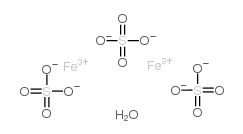IRON(III) SULFATE N-HYDRATE

IRON(III) SULFATE N-HYDRATE structure
|
Common Name | IRON(III) SULFATE N-HYDRATE | ||
|---|---|---|---|---|
| CAS Number | 15244-10-7 | Molecular Weight | 417.89300 | |
| Density | 3,097 g/cm3 | Boiling Point | 330ºC at 760 mmHg | |
| Molecular Formula | Fe2H2O13S3 | Melting Point | 480ºC (decomp) | |
| MSDS | Chinese USA | Flash Point | N/A | |
| Symbol |


GHS05, GHS07 |
Signal Word | Danger | |
|
Simultaneous removal of nitrogen and phosphorus from wastewater by means of FeS-based autotrophic denitrification.
Water Sci. Technol. 67(12) , 2761-7, (2013) The efficacy of iron(II) sulfide (FeS)-based autotrophic denitrification in simultaneous nitrogen and phosphorus removal from wastewater was studied with batch experiments. It was efficient at a wide pH range of 5-9, and temperature range of 10-40 °C. The con... |
|
|
Enhanced arsenite removal from water by Ti(SO4)2 coagulation.
Water Res. 47(13) , 4340-8, (2013) Coagulation with the conventional coagulants such as ferric and aluminum salts is not efficient for As(III) removal. In this study Ti(SO4)2 was employed for enhanced As(III) removal and Fe2(SO4)3 was used as a reference. The removal efficiencies of As(III) by... |
|
|
Characterization of cake layer structure on the microfiltration membrane permeability by iron pre-coagulation.
J. Environ. Sci. (China) 25(2) , 308-15, (2013) A cake layer is formed by coagulation aggregates under certain transmembrane pressure in the coagulation-microfiltration (MF) process. The characteristics of humic acid aggregates coagulated by different iron-based coagulants, such as charge, size, fractal di... |
|
|
Preference and drinking behavior of lactating dairy cows offered water with different concentrations, valences, and sources of iron.
J. Dairy Sci. 96(2) , 1164-76, (2013) Drinking water can contain high concentrations of Fe, mainly of the ferrous (Fe(2+)) valence. The current recommended upper tolerable concentration of Fe in drinking water for cattle (0.3mg/L) comes from guidelines for human palatability, but cattle may be ab... |
|
|
Removal of nickel and cadmium from battery waste by a chemical method using ferric sulphate.
Environ. Technol. 35(9-12) , 1263-8, (2014) The removal of nickel (Ni) and cadmium (Cd) from spent batteries was studied by the chemical method. A novel leaching system using ferric sulphate hydrate was introduced to dissolve heavy metals in batteries. Ni-Cd batteries are classified as hazardous waste ... |
|
|
Pulp treatment for extensive decay in primary teeth.
Cochrane Database Syst. Rev. 8 , CD003220, (2014) In children, dental caries is among the most prevalent chronic diseases worldwide. Pulp interventions are indicated for extensive tooth decay. Depending on the severity of the disease, three pulp treatment techniques are available: direct pulp capping, pulpot... |
|
|
Clinical and radiographic evaluation of pulpotomies in primary molars with formocresol, glutaraldehyde and ferric sulphate.
Oral Health Dent. Manag. 12(1) , 24-31, (2013) This in vivo study aimed to assess and compare the relative clinical and radiographic success of formocresol, glutaraldehyde and ferric sulphate as medicaments following pulpotomies in primary molars at three-monthly intervals over one year.The study was carr... |
|
|
Optimization of coagulation with PFS-PDADMAC composite coagulants using the response surface methodology experimental design technique.
Water Environ. Res. 85(5) , 456-65, (2013) In this study, two composite coagulants, PFPD1, and PFPD2, were prepared and studied with the inorganic polymer coagulant PFS. A response surface design was used to investigate the effect that changes in the level of coagulant dose and coagulation pH have on ... |
|
|
Long-term effectiveness of four pulpotomy techniques: 3-year randomised controlled trial.
Clin. Oral Investig. 16(4) , 1243-50, (2012) A pulpotomy is the therapy for management of pulp exposures due to caries in symptom-free primary molars. The aim was to longitudinally compare the relative effectiveness of the Er:YAG laser, calcium hydroxide and ferric sulphate techniques with dilute formoc... |
|
|
Iron induces hepatocytes death via MAPK activation and mitochondria-dependent apoptotic pathway: beneficial role of glycine.
Free Radic. Res. 46(10) , 1296-307, (2012) In the present study we investigated the beneficial role of glycine in iron (FeSO₄) induced oxidative damage in murine hepatocytes. Exposure of hepatocytes to 20 μM FeSO₄ for 3 hours enhanced reactive oxygen species (ROS) generation and induced alteration in ... |